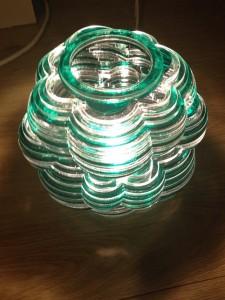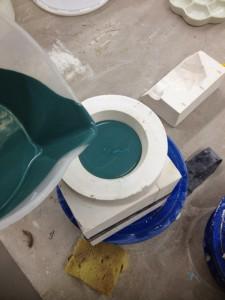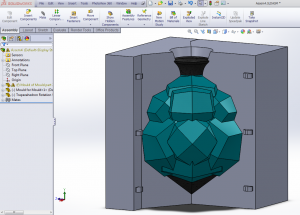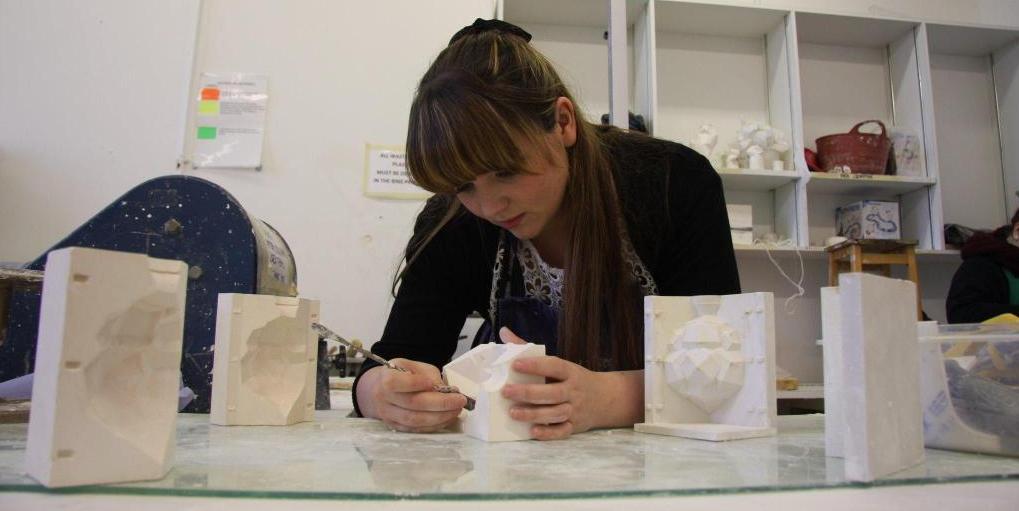Slipcasting is used for the mass production of pottery and ceramics, and it works best when employed to create complex-shaped objects not suited to throwing on a wheel or by hand.
A liquid clay slurry is usually poured into plaster molds to form a layer on the inside cavity of the mold. In a solid cast molding technique, objects like handles and platters are surrounded by plaster on all sides with a reservoir for the slip, and are removed when the piece within solidifies.
The technique can also be used for small-scale production runs or to produce limited editions of objects.
 Jade Crompton is a design graduate of Liverpool Hope University, and her work in ceramics and digital design combines the old school with the new.
Jade Crompton is a design graduate of Liverpool Hope University, and her work in ceramics and digital design combines the old school with the new.
“I see ceramics as a very traditional, old fashioned practice that needs to be modernized,” Crompton says. “During my undergraduate degree (work), I used the 3D modeling software SolidWorks to design functional vessels based on natural formations found in ice, lava and rock. I then used laser cut Perspex layers to build up my designs into models ready for mold making.”
According to Crompton, she uses traditional plaster mold making techniques prototyped via digital model making to make the molds for her slip casting pieces.
 She now uses a material called Parian semi porcelain slip. While standard semi-porcelain slip can take up to 45 minutes to set, Parian takes just 7-10 minutes.
She now uses a material called Parian semi porcelain slip. While standard semi-porcelain slip can take up to 45 minutes to set, Parian takes just 7-10 minutes.
The green-ware pieces are then fired at 1240 degrees F and require just one high-temperature pass, and she says the slip is “self-glazing” using that material and process. “The finish is perfect for my aesthetic,” Crompton says. “The finish is more matte than shiny, it shows more detail than glazing a piece as it would add an extra coating causing a dulling of my geometric forms.”
She adds that using this material does impose some design considerations. Whereas semi-porcelain normally shrinks some 10-12%, the Parian slip shrinks nearly 16%, and that requires her to design pieces and molds larger for casting. Ceramics techniques date back more than 20,000 years, but the artist’s new approach uses 3D printing to produce finely detailed and complex designs.
 Crompton says the original idea of how she should go about getting her work produced came as a result of a search for companies who could print in plaster. But when she found that it would cost too much to print each piece, and that ceramic printing wouldn’t allow the level of detail she required, she began to investigate how the process could work for her.
Crompton says the original idea of how she should go about getting her work produced came as a result of a search for companies who could print in plaster. But when she found that it would cost too much to print each piece, and that ceramic printing wouldn’t allow the level of detail she required, she began to investigate how the process could work for her.
Since the molds for slipcasting require a degree of absorbency, she decided to create basic 3D printed molds to provide the accuracy and speed she needed. The prices for her pieces range from £45 (around $68) for an insulated coffee mug to £215 (around $325) for her Perspex Bubble Light.
Artists are using 3D printing for everything from mold making to prototyping to creating finished pieces. Do you know of any artists who use 3D printing and scanning to create their work? Let us know about them in the 3D Printed Slipcast Pieces forum thread on 3DPB.com.
Subscribe to Our Email Newsletter
Stay up-to-date on all the latest news from the 3D printing industry and receive information and offers from third party vendors.
You May Also Like
Precision at the Microscale: UK Researchers Advance Medical Devices with BMF’s 3D Printing Tech
University of Nottingham researchers are using Boston Micro Fabrication‘s (BMF) 3D printing technology to develop medical devices that improve compatibility with human tissue. Funded by a UK grant, this project...
3D Printing Webinar and Event Roundup: April 21, 2024
It’s another busy week of webinars and events, starting with Hannover Messe in Germany and continuing with Metalcasting Congress, Chinaplas, TechBlick’s Innovation Festival, and more. Stratasys continues its advanced training...
3D Printing Webinar and Event Roundup: March 17, 2024
It’s another busy week of webinars and events, including SALMED 2024 and AM Forum in Berlin. Stratasys continues its in-person training and is offering two webinars, ASTM is holding a...
3D Printed Micro Antenna is 15% Smaller and 6X Lighter
Horizon Microtechnologies has achieved success in creating a high-frequency D-Band horn antenna through micro 3D printing. However, this achievement did not rely solely on 3D printing; it involved a combination...































